
| Version | Summary | Created by | Modification | Content Size | Created at | Operation |
|---|---|---|---|---|---|---|
| 1 | Dean Liu | -- | 3239 | 2022-10-13 01:45:40 |
Video Upload Options
A night vision device (NVD), also known as night optical/observation device (NOD) and night vision goggles (NVG), is an optoelectronic device that allows images to be produced in levels of light approaching total darkness. The image may be a conversion to visible light of both visible light and near-infrared, while by convention detection of thermal infrared is denoted thermal imaging. The image produced is typically monochrome, e.g. shades of green. NVDs are most often used by the military and law enforcement agencies, but are available to civilian users. The term usually refers to a complete unit, including an image intensifier tube, a protective and generally water-resistant housing, and some type of mounting system. Many NVDs also include optical components such as a sacrificial lens, or telescopic lenses or mirrors. An NVD may have an IR illuminator, making it an active as opposed to passive night vision device. Night vision devices were first used in World War II and came into wide use during the Vietnam War. The technology has evolved greatly since their introduction, leading to several "generations" of night vision equipment with performance increasing and price decreasing. Consequently, they are available for a wide range of applications, e.g. for gunners, drivers and aviators.
1. United States
1.1. Generations
The classification below was initially introduced by the US manufacturers through the US government. Other manufacturers do not abide by it.
Generation 0
In 1929, Hungarian physicist Kálmán Tihanyi invented the infrared-sensitive (night vision) electronic television camera for anti-aircraft defense in the UK.[1]
The first military night vision devices were introduced by the German Army as early as 1939, and were used in World War II. AEG started developing the first devices in 1935. In mid-1943, the Army began the first tests with infrared night-vision (Nachtjäger) devices and telescopic rangefinders mounted on Panther tanks. Two different arrangements were created and used on Panther tanks. The Sperber FG 1250 ("Sparrow Hawk"), with range up to 600 m, had a 30 cm infrared searchlight and an image converter operated by the tank commander. This was matched by an earlier experimental Russian version dubbed the PAU-2 and was field tested in 1942. From late 1944 to March 1945, there were some successful tests of FG 1250 sets mounted on Panther Ausf G tanks (and other variants). By the end of World War II, approximately 50 (or 63) Panthers had been equipped with the FG 1250, and saw combat on both the Eastern and Western Fronts. The "Vampir" man-portable system for infantry was used with StG 44 assault rifles.[2] Parallel development of night vision systems occurred in the US. The M1 and M3 infrared night sighting devices, also known as the "sniperscope" or "snooperscope", were introduced by the US Army in World War II,[3] and also used in the Korean War, to assist snipers.[4] These were active devices, using a large infrared light source to illuminate targets. Their image intensifier tubes used an anode and an S-1 photocathode, made primarily of silver, cesium, and oxygen, and electrostatic inversion with electron acceleration was used to achieve gain.[5]
Examples
- PAU-2
- PNV-57A Tanker goggles
- SU49/PAS 5
- T-120 Sniperscope, 1st model (World War II)
- M2 Sniperscope, 2nd model (World War II)
- M3 Sniperscope, 4th model (Korean War)
- AN/PAS-4 (Early Vietnam)
After World War II, the first practical commercial night vision device was developed by Vladimir K. Zworykin at Radio Corporation of America, intended for civilian use. Zworykin's idea came from a former radio guided-missile.[6] At that time infrared was commonly called black light, a term later restricted to ultraviolet. It was not a success due to its size and cost.[7]
Generation 1 (GEN I)
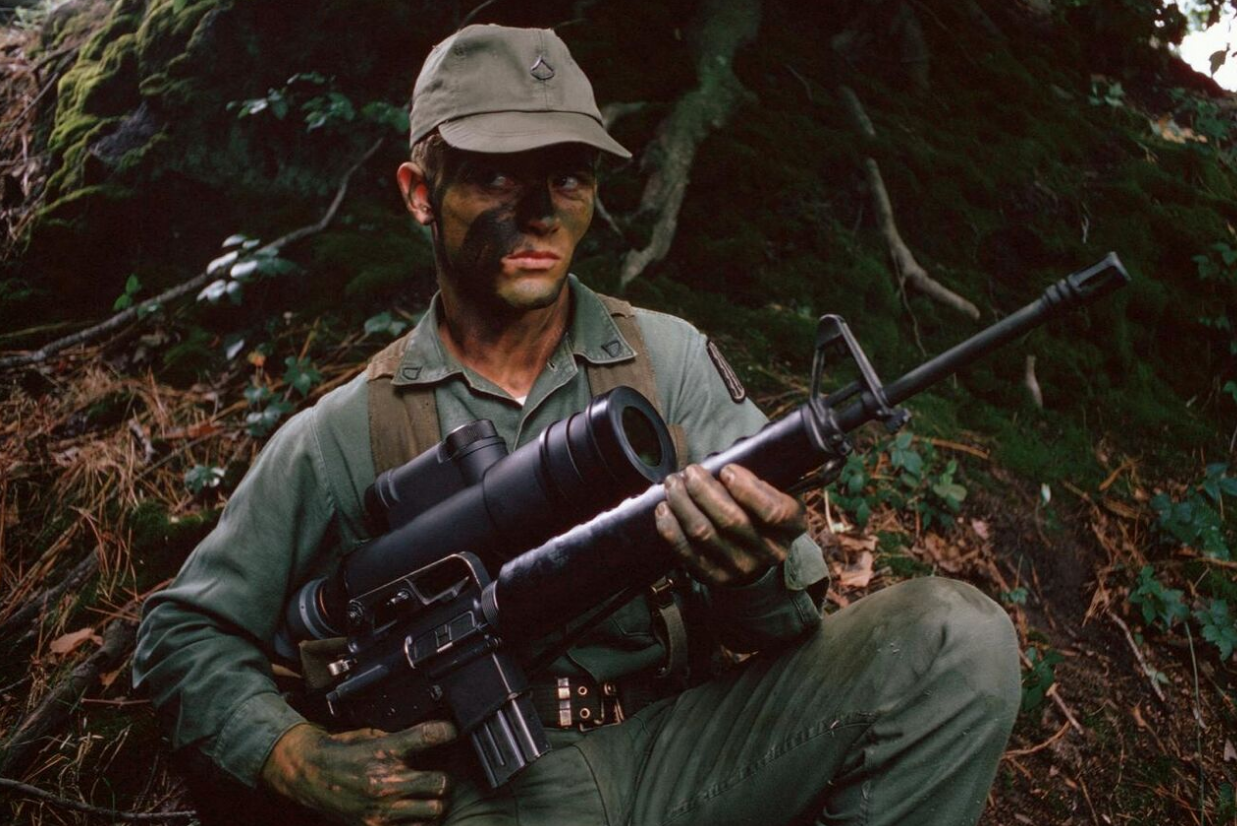
First generation passive devices, introduced during the Vietnam War and patented by the US Army, were an adaptation of earlier active GEN 0 technology, and rely on ambient light instead of an infrared light source. Using an S-20 photocathode, their image intensifiers produce a light amplification of around 1,000×,[8] but are quite bulky and require moonlight to function properly.
Examples:
- AN/PVS-1 Starlight scope
- AN/PVS-2 Starlight scope
- PNV-57E Tanker goggles
- PAS 6 Varo Metascope
Generation 2 (GEN II)
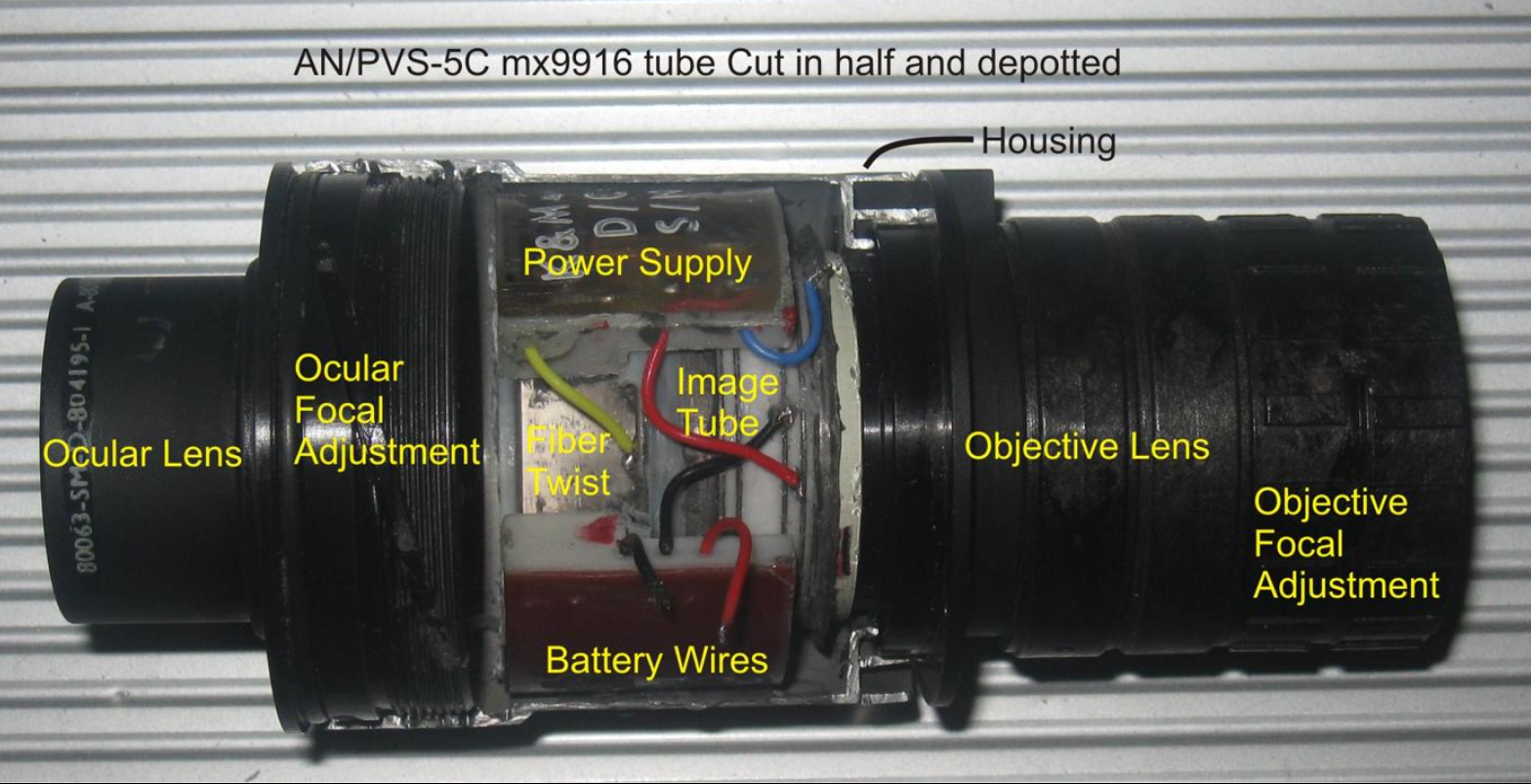
Second generation devices feature an improved image-intensifier tube utilizing micro-channel plate (MCP)[9] with an S-25 photocathode,[5] resulting in a much brighter image, especially around the edges of the lens. This leads to increased illumination in low ambient light environments, such as moonless nights. Light amplification is around 20,000×.[8] Also improved were image resolution and reliability.
Examples:
Later advancements in GEN II technology brought the tactical characteristics of "GEN II+" devices (equipped with better optics, SUPERGEN tubes, improved resolution and better signal-to-noise ratios)[12] into the range of GEN III devices, which has complicated comparisons.
Generation 3 (GEN III)
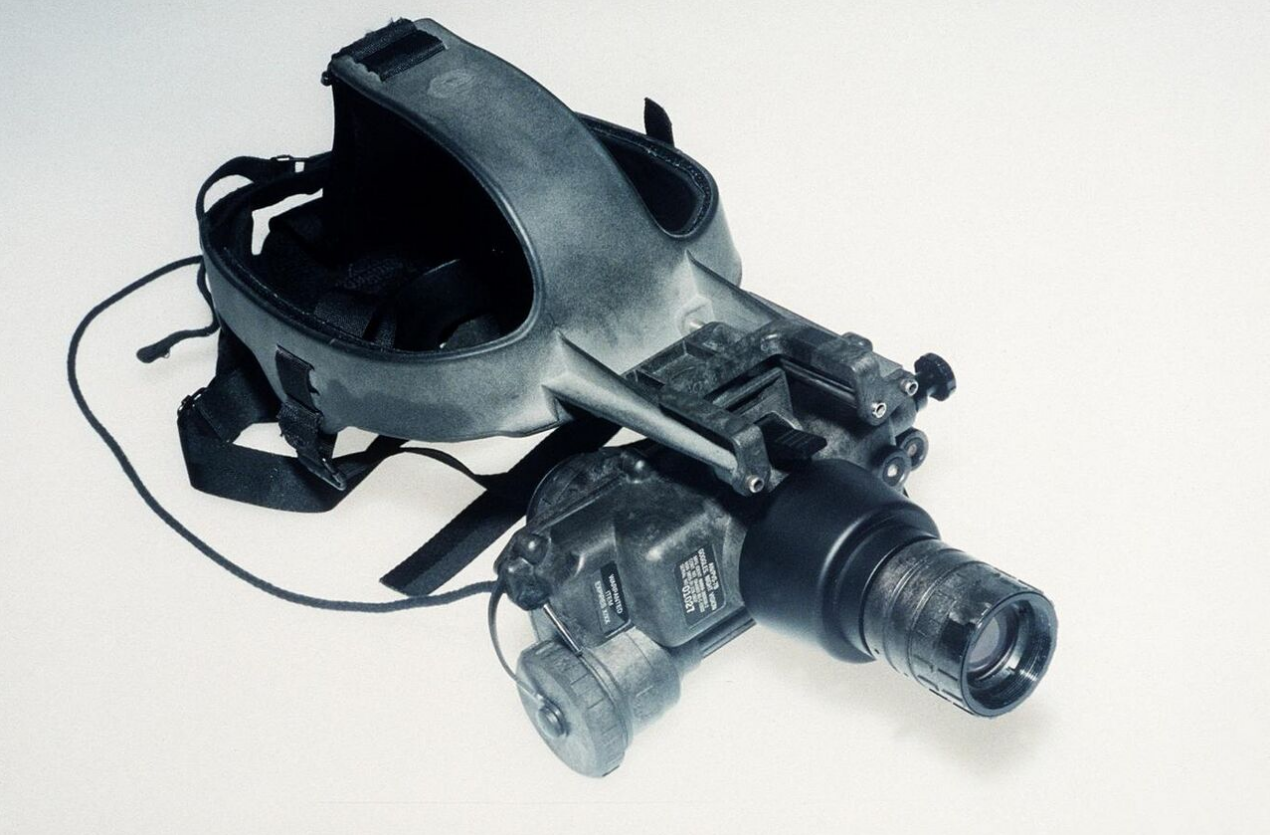
Third generation night vision systems maintain the MCP from Gen II, but now use a photocathode made with gallium arsenide, which further improves image resolution. In addition, the MCP is coated with an ion barrier film for increased tube life. However, the ion barrier causes fewer electrons to pass through, diminishing the improvement expected from the Gallium arsenide photocathode. Because of the ion barrier, the "halo" effect around bright spots or light sources is larger, too. The light amplification is also improved to around 30,000–50,000×.[8] Power consumption is higher than GEN II tubes.
Examples:
Generation 3+ (GEN III OMNI IV - VII)

U.S. Army Night Vision and Electronic Sensors Directorate (NVESD) is part of the governing body that dictates the name of the generation of night vision technologies. This was originally the Army Night Vision Laboratory (NVL) which worked within the US Army Research Labs. Although the recent increased performance associated with the GEN-III OMNI-VI - VII components is impressive, the U.S. Army has not yet authorized the use of the name GEN-IV for these components.
GEN-III OMNI-V - VII devices can differ from standard Generation 3 in one or both of two important ways. First, an automatic gated power supply system regulates the photocathode voltage, allowing the NVD to instantaneously adapt to changing light conditions.[16] The second is a removed or greatly thinned ion barrier, which decreases the number of electrons that are usually rejected by the Standard GEN III MCP, hence resulting in less image noise and the ability to operate with a luminous sensitivity at 2,850 K of only 700, compared to operating with a luminous sensitivity of at least 1,800 for GEN III image intensifiers.[17] The disadvantage to a thin or removed ion barrier is the overall decrease in tube life from a theoretical 20,000 hrs mean time to failure (MTTF) for Gen III type, to 15,000 hrs MTTF for GEN IV type. However, this is largely negated by the low number of image intensifier tubes that reach 15,000 hrs of operation before replacement.
While the consumer market classifies this type of system as Generation 4, the United States military describes these systems as Generation 3 Autogated tubes (GEN-III OMNI-VII). Moreover, as autogating power supplies can now be added to any previous generation of night vision, "autogating" capability does not automatically class the devices as a GEN-III OMNI-VII. Any postnominals appearing after a Generation type (i.e., Gen II +, Gen III +) do not change the generation type of the device, but instead indicates an advancement(s) over the original specification's requirements.[18]
Examples:
- AN/PVS-22[19]
- NVS-22
Auto-gating
The ATG function was designed to improve the BSP feature to be faster and to keep the best resolution and contrast at all times. It is particularly suitable for Aviator’s Night Vision goggles, operations in urban areas or for special operations. ATG is a unique feature that operates constantly, electronically reducing the “duty cycle” of the photocathode voltage by very rapidly switching the voltage on and off. This maintains the optimum performance of the I² tube, continuously revealing mission critical details, safeguarding the I² tube from additional damage and protecting the user from temporary blindness.
The benefits of ATG can easily be seen not only during day-night-day transitions, but also under dynamic lighting conditions when rapidly changing from low light to high light conditions (above 1 lx), such as sudden illumination of dark room. A typical advantage of ATG is best felt when using a weapon sight which experiences a flame burst during shooting (see figures below showing pictures taken at the impact zone of a dropped bomb). ATG would reduce the temporary blindness that a standard BSP tube would introduce, allowing them to continuously maintain “eyes on target”.
ATG provides added safety for pilots when flying at low altitudes, and especially during takeoffs and landings. Pilots operating with night vision goggles are constantly subjected to dynamic light conditions when artificial light sources, such as from cities, interfere with their navigation by producing large halos that obstruct their field of view.
Figure of Merit
In the late 1990s, innovations in photocathode technology significantly increased the signal-to-noise ratio, with newly developed tubes starting to surpass the performance of Gen 3 tubes.
By 2001, the United States federal government concluded that a tube’s “Generation” was not a determinant factor of a tube’s global performance, making the term “Generation” irrelevant in determining the performance of an Image Intensifier Tube, and therefore eliminated the term as a basis of export regulations.
Though image intensification technology employed by different manufacturers varies, from the tactical point of view a night vision system is an optical device that enables vision at low light. The US government itself has recognized the fact that technology itself makes little difference as long as an operator can see clearly at night. Consequently, the United States bases export regulations not on the generations, but on a calculated factor called figure of merit (FOM). The method of FOM calculation and its implications for export are briefly described in a National Defense University document called “The NATO Response Force”[20] authored by Jeffrey P. Bialos, the Executive Director of the Transatlantic Security and Industry Program at the Johns Hopkins University and Stuart L. Koehl, a Fellow at the Center for Transatlantic Relations of the same university.
… beginning in 2001, the U.S. implemented a new figure of merit (FOM) system for determining the release of night vision technology. FOM is an abstract measure of image tube performance, derived from the number of line pairs per millimeter multiplied by the tube's signal-to-noise ratio.
US-made tubes with a FOM greater than 1,400 are not exportable outside the US; however, the Defense Technology Security Administration (DTSA) can waive that policy on a case-by-case basis.
1.2. Other Technologies
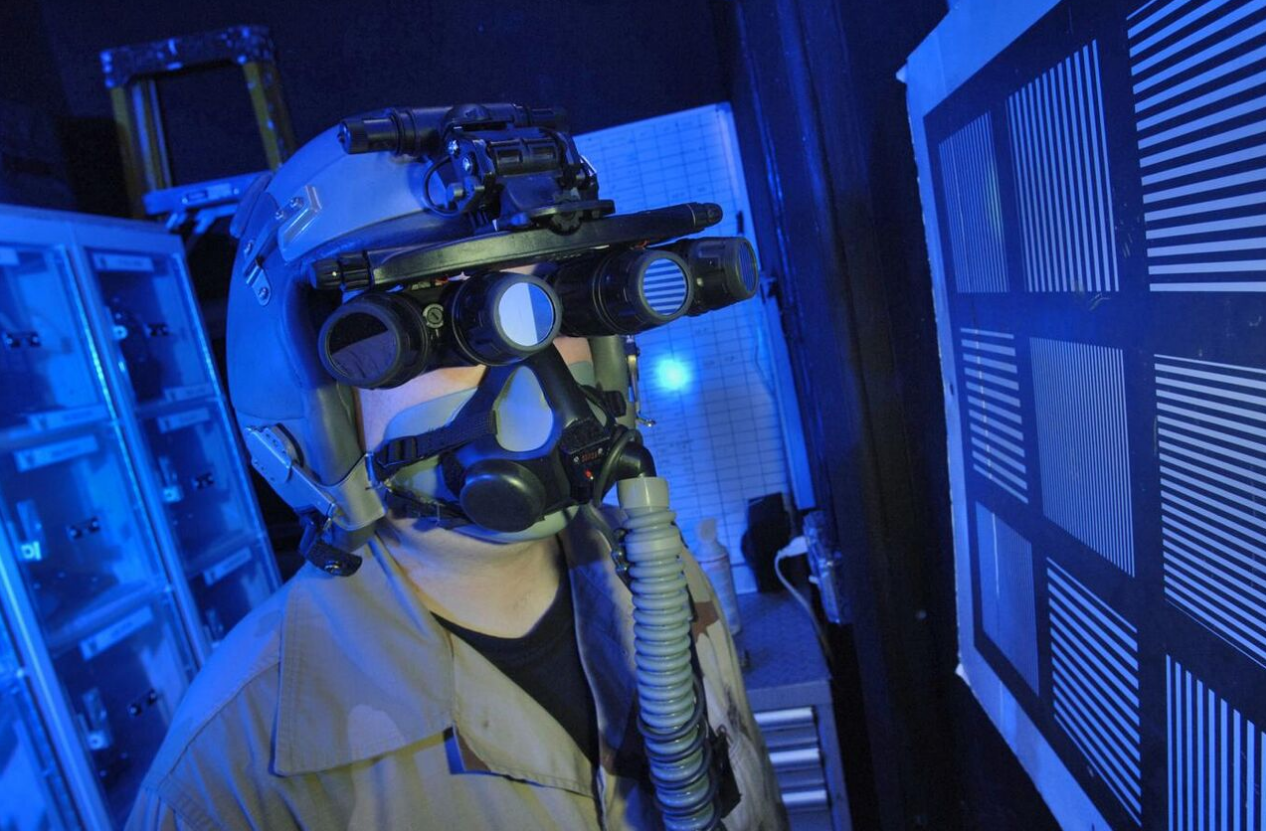
The United States Air Force experimented with panoramic night vision goggles (PNVGs) which double the user's field of view to around 95 degrees by using four 16 mm image intensifier tubes, rather than the more standard two 18 mm tubes. They are in service with A-10 Thunderbolt II, MC-130 Combat Talon and AC-130U Spooky aircrew,[21] and are also popular with special forces.
The AN/PSQ-20, manufactured by ITT (also known as the Enhanced Night Vision Goggle, ENVG), seeks to combine thermal imaging with image intensification, as does the Northrop Grumman Fused Multispectral Weapon Sight.[22][23]
A new technology is being introduced to the consumer market currently. It was first shown at the 2012 Shot Show in Las Vegas, NV by Armasight.[24] This technology called Ceramic Optical Ruggedized Engine (CORE) produces a higher performance Gen 1 tubes. The main difference between CORE tubes and standard Gen 1 tubes is introduction of a ceramic plate instead of a glass one. This plate is produced of specially formulated ceramic and metal alloys. Edge distortion is improved, photo sensitivity is increased and the resolution can get as high as 60 lp/mm. CORE is still considered Gen 1 as it does not utilize a micro channel plate.[25]
Scientists at the University of Michigan have developed a contact lens that can act as night vision device. The lens has a thin strip of graphene between layers of glass that reacts to photons to make dark images look brighter. Current prototypes only absorb 2.3 percent of light, so the percentage of light pickup has to rise before the lens can be viable. The graphene technology can be expanded into other uses like car windshields to increase night driving abilities. The U.S. Army is interested in the technology to potentially replace night vision goggles.[26]
The Sensor and Electron Devices Directorate (SEDD) of the US Army Research Laboratory developed quantum well infrared detector (QWID) technology. This technology’s epitaxial layers, which result in diode formation, compose a gallium arsenide or aluminum gallium arsenide system (GaAs or AlGaAs). It is particularly sensitive to infrared waves that are mid-long lengths. The Corrugated QWIP (CQWIP) broadens detection capacity by using a resonance superstructure to orient more of the electric field parallel so that it can be absorbed. Although between 77K and 85K cryogenic cooling is required, QWID technology is considered for constant surveillance viewing due to its claimed low cost and uniformity in materials.[27]
Materials from the II-VI compounds, such as HgCdTe, are used for high performing infrared light sensing cameras. In 2017, the US Army Research Labs in collaboration with Stony Brook University developed an alternative within the III-V family of compounds. InAsSb, a III-V compound, is commonly used commercially for opto-electronics in items such as DVDs and cell phones. Low cost and larger semiconductors frequently cause atomic spacing to decrease leading to size mismatch defects. To counteract this possibility in implementing InAsSb, scientists added a graded layer with increased atomic spacing and an intermediate layer of the substrate GaAs to trap any potential defects. This technology was designed with night time military operations in mind. [28]
2. Soviet Union and Russia
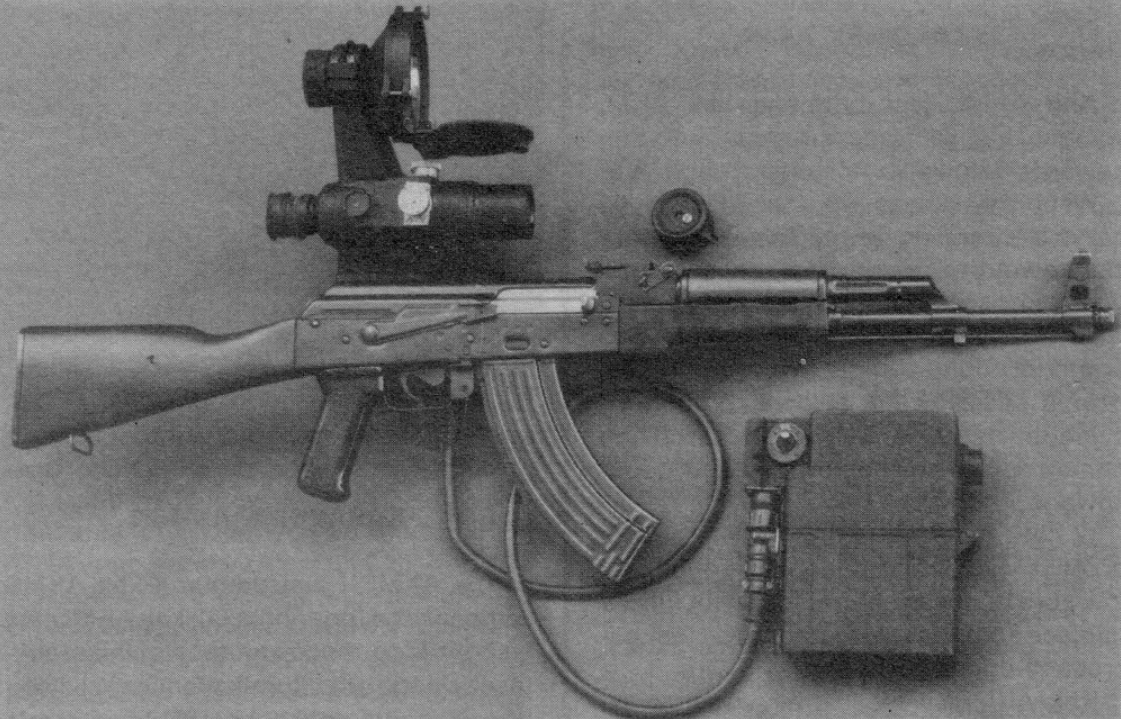
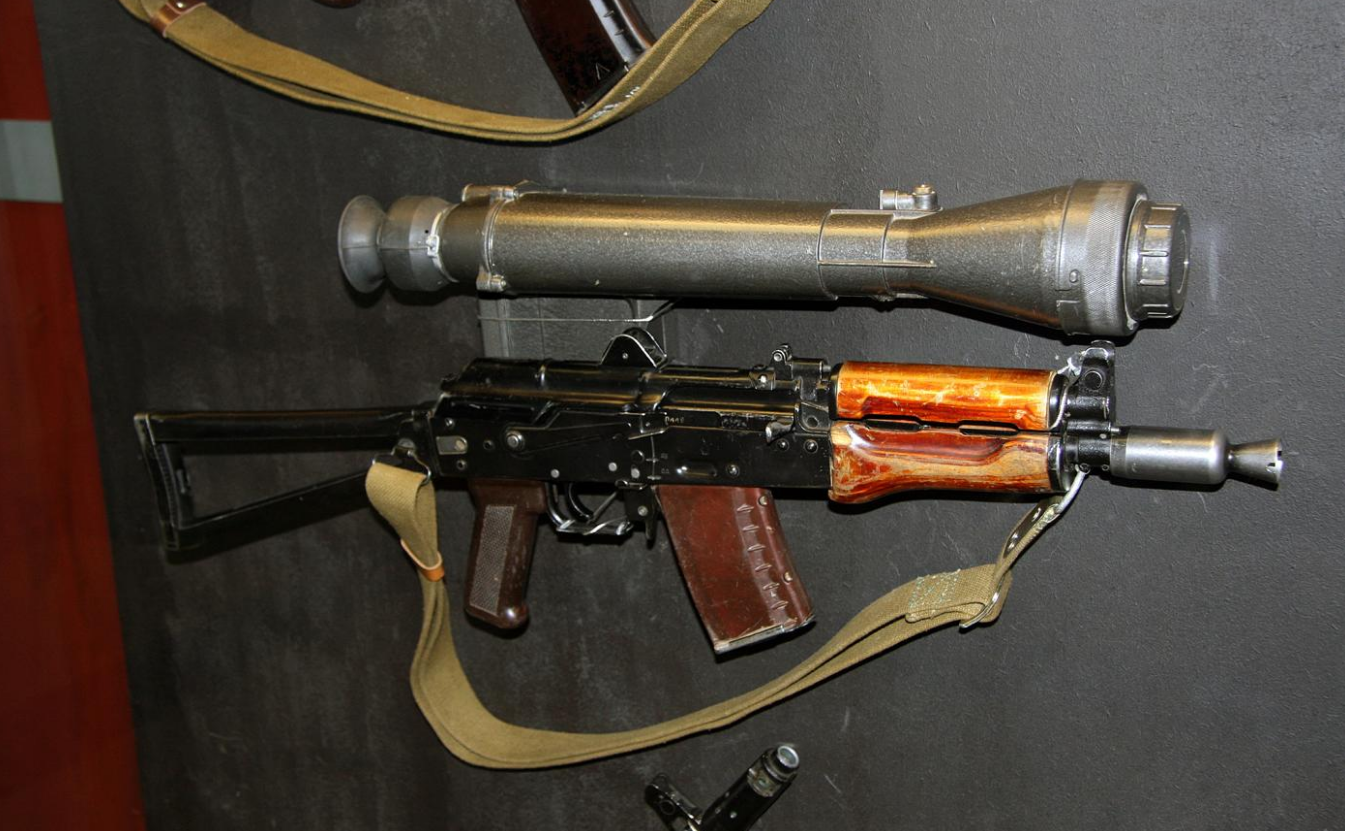
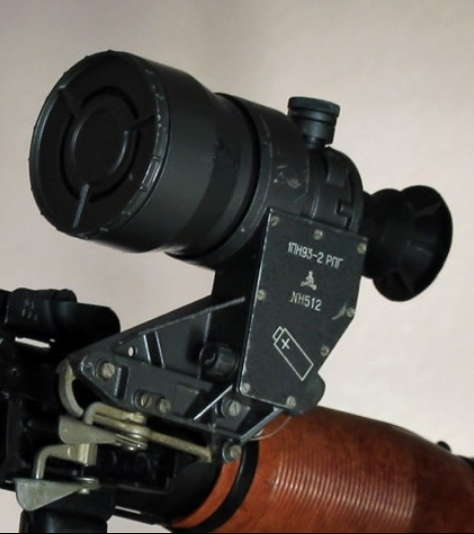
The Soviet Union and after it the Russian Federation has developed a range of night vision devices. Models used after 1960 by the Russian/Soviet Army are designated 1PNxx (Russian: 1ПНxx) where 1PN is the GRAU index of night vision devices. The PN stands for Nochnoy Pritsel (Russian: Ночной прицел) meaning night sight and the xx is the model number. Different models introduced around the same time use the same type of batteries and mechanism for mounting on the weapon. The multi-weapon models have replaceable elevation scales, with one scale for the ballistic arc of each supported weapon. The weapons supported include the AK-family, sniper rifles, light machine guns and hand-held grenade launchers.
- 1PN34 Refractor-based night sight for a range of small arms and grenade launchers, see photo.
- 1PN50 Refractor-based night observation binoculars.[29]
- 1PN51 Reflector-based night sight for a range of small arms and grenade launchers.[30]
- 1PN51-2 Reflector-based night sight for the RPG-29.[31]
- 1PN58 Refractor-based night sight for a range of small arms and grenade launchers.[32]
- 1PN93-2 Reflector-based night sight for the RPG-7D3, see photo.
- 1PN110 A more recent night sight for the RPG-29.[33]
- 1PN113 A night sight similar to the 1PN110, for the SV-98 sniper rifle.[33]
The Russian army has also contracted the development of and fielded a series of so-called counter-sniper night sights. The counter-sniper night sight is an active system that uses laser pulses from a laser diode to detect reflections from the focal elements of enemy optical systems and estimate their range. The vendor claims that this system is unparalleled:[34]
- 1PN106 counter-sniper night sight for the SVD sniper rifle and its SVDS variant.
- 1PN119 counter-sniper night sight for the PKMN and Pecheneg light machine guns.
- 1PN120 counter-sniper night sight for the SVDK sniper rifle.
- 1PN121 counter-sniper night sight for the ASVK large caliber sniper rifle.
- 1PN123 counter-sniper night sight for the SV-98 sniper rifle.
3. Legality
Certain countries (e.g. Hungary and other European Union members) regulate possession and or use of night-vision devices. Germany law forbids such devices if their purpose is to be mounted on firearms.[35][36]
Belgian firearms legislation forbids any night vision devices if they can be mounted on a firearm, even if not mounted they are considered illegal.[37]
In the Netherlands, although being a full member of the European Union, the possession of night vision devices is not regulated, nor is it forbidden to use them mounted on firearms. The usage of night vision equipment for night-time hunting (weapon mounted) is only allowed with a special permit in certain areas (the Veluwe) for hunting wild boar.
In Iceland, the use of night vision devices for hunting is prohibited, while there are no restrictions on the devices themselves.
New Zealand rescue helicopter services use several sets of 3rd-generation night vision goggles imported from the United States of America , and the country is required to restrict access to the equipment to comply with the strict regulations regarding their export.[38] There are no prohibitions on the ownership or use of night vision equipment for shooting non-indigenous game animals, such as rabbits, hares, deer, pigs, tahr, chamois, goats, wallabies, etc.
In the U.S., a 2010-2011 summary of State hunting regulations for the use of night vision equipment in hunting[39] listed 13 States in which the equipment is prohibited, 17 States with various restrictions (e.g. only for certain non-game species, and/or in a certain date range), and 20 States without restrictions. It did not summarize the regulations for thermal-imaging equipment.
In California , it is a misdemeanor to possess a device "designed for or adaptable to use on a firearm which, through the use of a projected infrared light source and electronic telescope, enables the operator thereof to visually determine and locate the presence of objects during the night-time".[40] This essentially covers scopes using Gen0 technology, but not the subsequent generations. There was an effort in 1995[41] to further expand restrictions to forbid night vision devices that did not incorporate a light source, but it did not become law.
In Minnesota, as of 2014, "A person may not possess night vision or thermal imaging equipment while taking wild animals or while having in possession [an uncased and loaded weapon] that could be used to take wild animals."[42] There is an exception for law-enforcement and military use. The night-vision prohibition was enacted in 2007, and the thermal-imaging prohibition was added in 2014. Two bills were introduced in the Minnesota Legislature in 2016, proposing to allow night vision and thermal-imaging equipment for, respectively, 1) "predator" or 2) "unprotected wild animal" hunting.[43]
References
- Naughton, Russell (10 August 2004). "Kalman Tihanyi (1897 - 1947)". Monash University. http://www.ctie.monash.edu.au/hargrave/tihanyi.html. Retrieved 15 March 2013.
- "German Infrared Night-Vision Devices – Infrarot-Scheinwerfer". http://www.achtungpanzer.com/articles/ir.htm. Retrieved 16 March 2018.
- "Bull's-eyes in the Night". Popular Science, July 1946, p. 73. https://books.google.com/books?id=7SADAAAAMBAJ&pg=PA13
- Jeff Tyson. "How Night Vision Works". HowStuffWorks. http://electronics.howstuffworks.com/gadgets/other-gadgets/nightvision4.htm. Retrieved 2011-03-01.
- "Image Intensification Tube Technology and Evolution". GlobalSecurity.org. http://www.globalsecurity.org/space/systems/images/night_vision.gif. Retrieved 2011-03-01.
- Pennsylvania State University. Zworykin, Vladimir. Biographical sketch. http://pabook.libraries.psu.edu/palitmap/bios/Zworykin__Vladimir.html
- "Black-Light Telescope Sees in the Dark". Popular Science Monthly. March 1936. https://books.google.com/books?id=fCYDAAAAMBAJ&pg=PA33
- Pike, John. "Night Vision Goggles (NVG)". http://www.globalsecurity.org/military/systems/ground/nvg.htm. Retrieved 16 March 2018.
- "Night Vision Equipment by Pulsar FAQ". http://www.pulsar-nv.com/products_list.aspx. Retrieved 16 March 2018.
- Pike, John. "AN/PVS-4 Individual Weapon Night Sight". http://www.globalsecurity.org/military/systems/ground/an-pvs-4.htm. Retrieved 16 March 2018.
- Pike, John. "AN/PVS-5 Night Vision Goggles". http://www.globalsecurity.org/military/systems/ground/an-pvs-5.htm. Retrieved 16 March 2018.
- "Night Vision Area - PHOTONIS". http://www.photonis.com/en/night_vision. Retrieved 16 March 2018.
- Pike, John. "AN/PVS-7 Night Vision Goggle". http://www.globalsecurity.org/military/systems/ground/an-pvs-7.htm. Retrieved 16 March 2018.
- AN/PVS-14, MONOCULAR NIGHT VISION DEVICE (MNVD) http://www.globalsecurity.org/military/systems/ground/an-pvs-14.htm
- "CANVS COLOR NIGHT VISION GOGGLES". http://www.canvs.com/cnvs4949.htm. Retrieved 16 March 2018.
- "\\Baksan\Shared Docs\For Candace\New Folder\LET.tif". http://www.nvisionoptics.com/files/docs/articles/articleletmay2007.pdf. Retrieved 16 March 2018.
- "www.nivitech.com / Nightvision Technology / Principles of Nightvision Devices". http://www.nivitech.com/nightvision-gns.htm. Retrieved 16 March 2018.
- "How Night Vision Works in night vision Goggles, Scopes, Binoculars, Riflescopes - ATN corp". http://www.atncorp.com/HowNightVisionWorks#gen11. Retrieved 16 March 2018.
- "nightvis.com". http://www.nightvis.com/nv_sights/ANPVS22_Universal_Night_Sight.html. Retrieved 16 March 2018.
- Jeffrey P. Bialos; Stuart L. Koehl (September 2005). "The NATO Response Force". National Defense University. http://www.dtic.mil/cgi-bin/GetTRDoc?Location=U2&doc=GetTRDoc.pdf&AD=ADA450219. Retrieved 2011-03-01.
- "Main Login". http://www.military.com/soldiertech/0,14632,Soldiertech_PNVG,,00.html. Retrieved 16 March 2018.
- "Defense Tech: Army Optic Combines Heat, Light for Better Sight". http://www.defensetech.org/archives/003732.html. Retrieved 16 March 2018.
- "Northrop Grumman Delivers First Fused Multispectral Weapon Sight to U.S. Army". http://www.irconnect.com/noc/press/pages/news_releases.html?d=65353. Retrieved 16 March 2018.
- "About Armasight brand". https://www.outdoorsbay.com/catalogue/brand/armasight/. Retrieved 2015-12-29.
- "Night Vision Generations". http://aunv.blackice.com.au/cgi-bin/nightvision/forum?index=reviews&story=SPARKCORE.
- Scientists Develop Night Vision Contact Lens - Defensetech.org, 28 March 2014 http://defensetech.org/2014/03/28/scientists-develop-night-vision-contact-lens/
- Ratches, James A, et al. “Some Recent Sensor-Related Army Critical Technology Events .” Defense and Technology Paper, Center for Technology and National Security Policy National Defense University , Feb. 2013, [1].
- ""Researchers Develop New Material for Army Night-Time Operations"". https://www.azom.com/news.aspx?newsID=48667. Retrieved 5 July 2018.
- (in ru) БИНОКЛЬ НОЧНОЙ 1ПН50 ТЕХНИЧЕСКОЕ ОПИСАНИЕ И ИНСТРУКЦИЯ ПО ЭКСПЛУАТАЦИИ. 55 pages.
- (in ru) ИЗДЕЛИЕ 1ПН51 ТЕХНИЧЕСКОЕ ОПИСАНИЕ И ИНСТРУКЦИЯ ПО ЭКСПЛУАТАЦИИ. January 1992. 48 pages.
- (in ru) ИЗДЕЛИЕ 1ПН51-2 ТЕХНИЧЕСКОЕ ОПИСАНИЕ И ИНСТРУКЦИЯ ПО ЭКСПЛУАТАЦИИ. September 1991. 52 pages.
- (in ru) ИЗДЕЛИЕ 1ПН58 ТЕХНИЧЕСКОЕ ОПИСАНИЕ И ИНСТРУКЦИЯ ПО ЭКСПЛУАТАЦИИ. February 1991. 53 pages.
- "1PN110 and 1PN113 Night Vision Sights". gunsru.ru. http://gunsru.ru/rg_pricel_1PN110_eng.html. Retrieved 2014-11-26.
- "Anti-Sniper Special Purpose Night Vision Sights". gunsru.ru. http://gunsru.ru/rg_pricel_Anti-Sniper_eng.html. Retrieved 2015-03-15.
- Section 19 5a of the German Bundesjagdgesetz (BJagdG) states: "It is forbidden to use artificial light sources, mirrors, devices to illuminate or light targets, or night vision devices with image converters or electronic amplification intended for guns." These aids are not banned for observation purposes but for catching or killing game.
- "Lust auf Nachtjagd geht nicht ohne Nachtsichtgeräte Thermalgeräte" (in de-DE). 12 July 2017. https://jaeger-werden.de/jagdforum/lust-auf-nachtjagd-geht-nicht-ohne-nachtsichtgeraete-und-thermalgeraete-teil-1. Retrieved 21 September 2018.
- "Wapenwet – Gecoördineerde versie | Wapenunie Online". Wapenunie.be. http://www.wapenunie.be/node/21. Retrieved 2016-12-23.
- "Seeing in the Dark", Vector, magazine of the Civil Aviation Authority of New Zealand, January/February 2008, pages 10–11
- "A 50 State guide - is night vision legal to use for hunting in my State?". 2010. http://www.hightechredneckincorporated.com/articles.asp?ID=261.
- "WAIS Document Retrieval". http://www.leginfo.ca.gov/cgi-bin/waisgate?WAISdocID=24717320313+1+0+0&WAISaction=retrieve. Retrieved 16 March 2018.
- "AB 1059". http://info.sen.ca.gov/pub/95-96/bill/asm/ab_1051-1100/ab_1059_cfa_950417_155505_asm_comm.html. Retrieved 16 March 2018.
- "MN Statutes Section 97B.086". State of MN. https://www.revisor.mn.gov/statutes/?id=97B.086. Retrieved 31 March 2016.
- Orrick, Dave (2016-03-29). "Would night vision make coyote hunting safer? Divisions arise.". Pioneer Press. http://www.twincities.com/2016/03/29/would-night-vision-make-coyote-hunting-safer-divisions-arise/.




